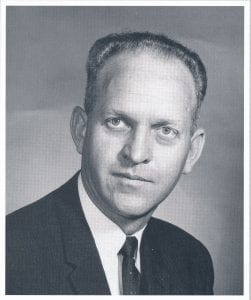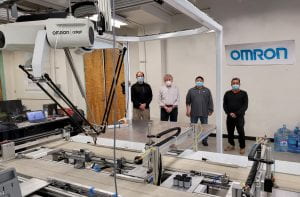 While California would address many issues in the development of 20th century state higher education, it can safely be said that San Jose State University and its College of Engineering’s challenge against certain restrictions in 1953 created a watershed in the development of the state university system’s role in California education, and made a significant and positive impact on what state schools could offer to meet the growing needs of the public.
While California would address many issues in the development of 20th century state higher education, it can safely be said that San Jose State University and its College of Engineering’s challenge against certain restrictions in 1953 created a watershed in the development of the state university system’s role in California education, and made a significant and positive impact on what state schools could offer to meet the growing needs of the public.
As you read this timeline of developments between 1946 and 1960, it is helpful to know that the American Engineers’ Council for Professional Development (ECPD), established in June 1932, was an engineering professional body dedicated to the education, accreditation, regulation and professional development of the engineering professionals and students in the United States. ECPD grew and has changed its name to ABET, Inc. and its focus solely to accreditation.
1946: An Engineering program was founded at San Jose State College (SJSC), with Ralph Smith as its first full-time professor
1947: The state Board of Education first authorized engineering as a major with an AB degree.
1948: First graduating class of Engineering students– 3 degrees granted, 2 in comms, 1 in construction. That year, the Strayer Committee produced a survey of the Higher-Education needs of California. Results were against state schools offering professional engineering programs or programs that could be accredited by the ECPD. The state political lobby was against it, in part because many of the politicians came from University of California (UC) schools.
1949: Construction, Production and Communications majors were converted into BS programs, while Aeronautics and IT remained AB majors.
During the 1950’s, the California Board of Education prevented California state/normal schools from offering masters degrees. SJSC offered something more like a professional vocational degree. In 1950 and ‘51, meetings were held among representatives from the state department of Education, state colleges and UCs to resolve Engineering issues in state schools.
1952: Accreditation, graduate study and research were considered the business of the University of California schools only. State colleges were told to concentrate on training “practical engineers,” that is, technicians. Many industries in the valley, however, were not hiring grads without full engineering degrees, or would hire engineers who started at SJSC, but completed a full degree elsewhere in the valley (Santa Clara or Stanford).
1953: State Department of Education and the UC Regents unanimously approved restricting state schools from seeking ECPD accreditation, grad study, and engineering research, in an agreement called “Engineering Education in the State Colleges and the University of California.”
1956: There were now 946 students in the SJSC Engineering college. All curricula except Aeronautics were revised to meet ECPD standards, and functional names were changed. Construction became Civil Engineering, Production became Industrial Engineering, Electronics changed to Electrical. At this time the General Engineering program was created, so that there would still be a general engineer’s professional training track. Also during this year, Aeronautical Maintenance and Aeronautical Management were changed to BS degrees. Although accreditation was not possible at this time, the San Jose State professors tried to make them as close as possible to the accredited programs offered elsewhere.

Dean Norm Gunderson
Dean Norman O. Gunderson later said, “I became totally involved in the problem almost immediately upon my assumption of the Headship of the Division of Engineering and Mathematics in the summer of 1956 — the title Dean wasn’t granted until some years later. An industry representative walked into my office to inquire about the future availability of graduate work and accredited undergraduate programs — these were important lures when recruiting new engineering employees for the rapidly expanding industrial complex of the Valley. I explained the dilemma posed by the ’53 Agreement — and we were off and away into the exciting two years.”
1957: Application and Sales Engineering were phased out, and the Engineering Metallurgy (later to be called Materials Engineering) program was created. IBM’s request for a graduate program in Electrical Engineering at SJSC kicked off another battle to get the restrictions lifted for state schools. With the participation of local industry and government leaders and the assistance of Assemblyman Bruce Allen, Gunderson became the main state college voice for granting accreditation to state engineering degrees.
“As part of the strategy of dramatizing the harm done to us because of not being able to be accredited, I even wrote a detailed proposal for a $100,000 grant from the Atomic Energy Commission for a training reactor which was available only to accredited institutions.” — Dean Gunderson
1958: A Joint Staff study (headed by UC, DOE and Santa Clara U leaders) offered a compromise — they recommended that restrictions against seeking accreditation be lifted for state schools, but that they still not be allowed to create graduate programs. This concession was unacceptable to the San Jose leaders, and Bruce Allen counterproposed with AB 1, a bill proposing two changes to the state education code, broadening the state college charter to include training in engineering, science, and math, and to establish, with state BOE approval, courses of instruction leading to masters degrees in engineering.
As support for AB 1 grew, and the biases of UC-alumni politicians were no longer sufficient to defend the 1953 decision, the UC and state legislators came together to turn AB 1 into State Concurrent Resolution No. 9, which called for immediate granting of permission to state schools to seek accreditation and create graduate programs in colleges where there was local demand for advanced engineering education. SCR 9 passed quickly in April 1958. Now, State schools were granted permission to seek ECPD accreditation and offer masters programs. Having already made some programs as close as possible to accreditable status, San Jose quickly prepped for and hosted an ECPD site visit in Nov. 1958.
1959: As a result of AB 1 and SCR 9, San Jose was able to establish its first masters program, in Electrical Engineering. As a result of the ECPD site visit, ECPD granted accreditation to San Jose’s Civil and Electrical Engineering programs.
Still, conflict between state colleges and the UC had intensified over a host of issues, and resolution had been kicked back to the state legislature. The host of bills, amendments and resolutions on public higher education got streamlined into Assembly Concurrent Resolution No. 88, introduced by Dorothy Donahoe. It called for an immediate Master Plan for Higher Ed in California, and a survey team was formed to review and resolve all the issues in public higher education. In late 1959, the Regents and the State Board of Education approved the team’s findings.
Spring 1960: Legislation containing all the key features of the Master Plan was ratified in the State Assembly,
and named the Donahoe Higher Education Act of 1960. Signed into law by Governor Edmund Brown Sr., the Donahoe Act removed state colleges from the governance of the State Board of Education, and created the California State College system, with its own chancellor and board of trustees appointed to govern it. It also created the Coordinating Council for Higher Education, consisting of members from the UCs, state schools, junior colleges, private colleges, and members of the public.
 We were deeply saddened to learn of Charles W. (Chuck) Davidson’s passing on March 25, 2021, and the college community is mourning his loss. An avid reader and lifelong learner, Chuck was a student of life and an ardent supporter of San José State University.
We were deeply saddened to learn of Charles W. (Chuck) Davidson’s passing on March 25, 2021, and the college community is mourning his loss. An avid reader and lifelong learner, Chuck was a student of life and an ardent supporter of San José State University. 


